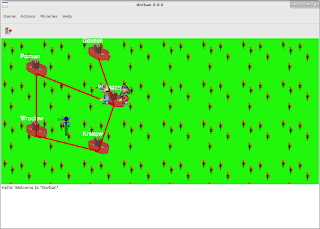I would like to explain why it is problematic in Svarog to keep "real" states. Let's assume we have four boolean hidden variables. I will use the new, Borsuk syntax:
type boolean={false, true};
type place={Krakow, Warszawa, Wroclaw, Poznan};
hidden variable it_is_raining_in_(X:place):boolean;
This results in four hidden variables:
it_is_raining_in_Krakow:{false, true}
it_is_raining_in_Warszawa:{false, true}
it_is_raining_in_Wroclaw:{false, true}
it_is_raining_in_Poznan:{false, true}
In Svarog we would have 2^4=16 states:
state1={it_is_raining_in_Krakow=>false,it_is_raining_in_Warszawa=>false,it_is_raining_in_Wroclaw=>false,it_is_raining_in_Poznan=>false}; state2={it_is_raining_in_Krakow=>false,it_is_raining_in_Warszawa=>false,it_is_raining_in_Wroclaw=>false,it_is_raining_in_Poznan=>true}; state3={it_is_raining_in_Krakow=>false,it_is_raining_in_Warszawa=>false,it_is_raining_in_Wroclaw=>true,it_is_raining_in_Poznan=>false}; state4={it_is_raining_in_Krakow=>false,it_is_raining_in_Warszawa=>false,it_is_raining_in_Wroclaw=>true,it_is_raining_in_Poznan=>true}; state5={it_is_raining_in_Krakow=>false,it_is_raining_in_Warszawa=>true,it_is_raining_in_Wroclaw=>false,it_is_raining_in_Poznan=>false}; state6={it_is_raining_in_Krakow=>false,it_is_raining_in_Warszawa=>true,it_is_raining_in_Wroclaw=>false,it_is_raining_in_Poznan=>true}; state7={it_is_raining_in_Krakow=>false,it_is_raining_in_Warszawa=>true,it_is_raining_in_Wroclaw=>true,it_is_raining_in_Poznan=>false}; state8={it_is_raining_in_Krakow=>false,it_is_raining_in_Warszawa=>true,it_is_raining_in_Wroclaw=>true,it_is_raining_in_Poznan=>true}; state9={it_is_raining_in_Krakow=>true,it_is_raining_in_Warszawa=>false,it_is_raining_in_Wroclaw=>false,it_is_raining_in_Poznan=>false}; state10={it_is_raining_in_Krakow=>true,it_is_raining_in_Warszawa=>false,it_is_raining_in_Wroclaw=>false,it_is_raining_in_Poznan=>true}; state11={it_is_raining_in_Krakow=>true,it_is_raining_in_Warszawa=>false,it_is_raining_in_Wroclaw=>true,it_is_raining_in_Poznan=>false}; state12={it_is_raining_in_Krakow=>true,it_is_raining_in_Warszawa=>false,it_is_raining_in_Wroclaw=>true,it_is_raining_in_Poznan=>true}; state13={it_is_raining_in_Krakow=>true,it_is_raining_in_Warszawa=>true,it_is_raining_in_Wroclaw=>false,it_is_raining_in_Poznan=>false}; state14={it_is_raining_in_Krakow=>true,it_is_raining_in_Warszawa=>true,it_is_raining_in_Wroclaw=>false,it_is_raining_in_Poznan=>true}; state15={it_is_raining_in_Krakow=>true,it_is_raining_in_Warszawa=>true,it_is_raining_in_Wroclaw=>true,it_is_raining_in_Poznan=>false}; state16={it_is_raining_in_Krakow=>true,it_is_raining_in_Warszawa=>true,it_is_raining_in_Wroclaw=>true,it_is_raining_in_Poznan=>true};
When we assume they are independent and use the projection states then we have only eight of them:
projection_state1={it_is_raining_in_Krakow=>false}
projection_state2={it_is_raining_in_Krakow=>true}
projection_state3={it_is_raining_in_Warszawa=>false}
projection_state4={it_is_raining_in_Warszawa=>true}
projection_state5={it_is_raining_in_Wroclaw=>false}
projection_state6={it_is_raining_in_Wroclaw=>true}
projection_state7={it_is_raining_in_Poznan=>false}
projection_state8={it_is_raining_in_Poznan=>true}
This difference increases when we have many hidden variables. For boolean ones there is 2^n real states and 2*n projection states. In Borsuk we will be able to maintain hundreds of thousands of hidden variables, which is clearly impossible in Svarog.
In Borsuk a belief will be a vector of projections, with each projection containing a map.
projection1 = {projection_state1=>x, projection_state2=>y}
with x+y = 1.0


